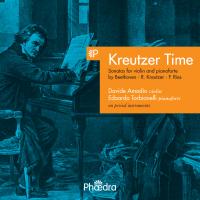Kreutzer Time
Davide Amodio, violino (F. Pique, 1793; archetto, Renzo Ghirardelli; corde in budello, Charles Riché)
Edoardo Torbianelli, pianoforte (Iakesh, 1823)
Beethoven, “Kreutzer Sonate”
R. Kreutzer, Sonate
F. Ries, Sonate
Vienna, 24 maggio 1803 ore 8 del mattino, al Teatro Augarten viene eseguita, per la prima volta, la Sonata op. 47 di Ludwig van Beethoven, a Kreutzer; al pianoforte lo stesso autore e al violino lo straordinario dedicatario della sonata: George Augustus Polgreen Bridgetower, per Beethoven Brischdauer o semplicemente Bursch. Ci si potrebbe chiedere perché registrare un’altra edizione della Sonata a Kreutzer? Eppure con un piano del 1823 (quindi appena di venti anni dopo la prima esecuzione) gemello di quello appartenuto a Beethoven, un violino del 1793 senza spalliera, senza mentoniera, con tutte le corde in budello (le prime tre nude e la quarta rivestita a mano di un ï¬lo di argento), con un ponticello di forma tardo-settecentesca, l’aiuto di un arco classico copia di uno della ï¬ne del XVIII secolo proveniente dalla casa di Mozart a Salisburgo, è possibile, e non è un paradosso, fare qualcosa di nuovo. Adottando anche la tecnica e la postura del corpo, secondo le indicazioni dei metodi coevi alla musica, basta, allora, farsi guidare dagli strumenti stessi verso una comprensione profonda del testo, intendendo il grande “genio” dell’improvvisazione; non solo nella possibilità di aggiungere o togliere note, ma nel modo di sentire i movimenti delle ï¬ gurazioni come se fossero mobili, vivide. È noto che Beethoven fosse un grandissimo improvvisatore, e proprio Bridgetower gli diede una forte sponda. Dunque abbiamo cercato questo spirito, non il riprodurre il suono della serata del 24 maggio 1803, cosa impossibile anche ai loro stessi attori, non ritrovare un archeologico senso di autenticità, ma lo spirito fresco dell’improvvisazione.
